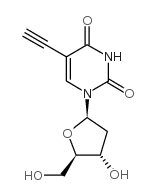5-Ethynyl-2'-deoxyuridine

5-Ethynyl-2'-deoxyuridine structure
|
Common Name | 5-Ethynyl-2'-deoxyuridine | ||
|---|---|---|---|---|
| CAS Number | 61135-33-9 | Molecular Weight | 252.22300 | |
| Density | 1.55g/cm3 | Boiling Point | N/A | |
| Molecular Formula | C11H12N2O5 | Melting Point | 199 °C | |
| MSDS | Chinese USA | Flash Point | N/A | |
| Symbol |

GHS08 |
Signal Word | Danger | |
|
Oncogene-mediated regulation of p53 ISGylation and functions.
Oncotarget 5(14) , 5808-18, (2014) Oncogene-mediated cellular transformation is a multistep process involving activation of growth-promoting pathways as well as inactivation of tumor suppressors. We recently found that ISGylation of the p53 tumor suppressor is an important novel mechanism to c... |
|
|
CD11c(hi) Dendritic Cells Regulate Ly-6C(hi) Monocyte Differentiation to Preserve Immune-privileged CNS in Lethal Neuroinflammation.
Sci. Rep. 5 , 17548, (2015) Although the roles of dendritic cells (DCs) in adaptive defense have been defined well, the contribution of DCs to T cell-independent innate defense and subsequent neuroimmunopathology in immune-privileged CNS upon infection with neurotropic viruses has not b... |
|
|
The Epigenome of Schistosoma mansoni Provides Insight about How Cercariae Poise Transcription until Infection.
PLoS Negl. Trop. Dis. 9 , e0003853, (2015) Chromatin structure can control gene expression and can define specific transcription states. For example, bivalent methylation of histone H3K4 and H3K27 is linked to poised transcription in vertebrate embryonic stem cells (ESC). It allows them to rapidly eng... |
|
|
Mapk/Erk activation in an animal model of social deficits shows a possible link to autism.
Mol. Autism 5 , 57, (2015) There is converging preclinical and clinical evidence to suggest that the extracellular signal-regulated kinase (ERK) signaling pathway may be dysregulated in autism spectrum disorders.We evaluated Mapk/Erk1/2, cellular proliferation and apoptosis in BTBR mic... |
|
|
Nicorandil protects mesenchymal stem cells against hypoxia and serum deprivation-induced apoptosis.
Int. J. Mol. Med. 36 , 415-23, (2015) Nicorandil, an adenosine triphosphate (ATP)-sensitive potassium (K(ATP)) channel opener, has been shown to exert a significant protective effect against ischemic heart injury. In the present study, we investigated the anti-apoptotic effects of nicorandil on r... |
|
|
MicroRNA-200a Targets EGFR and c-Met to Inhibit Migration, Invasion, and Gefitinib Resistance in Non-Small Cell Lung Cancer.
Cytogenet. Genome Res. 146 , 1-8, (2015) Lung cancer, especially non-small cell lung cancer (NSCLC), is the major cause of cancer death worldwide. Mutations in epidermal growth factor receptor (EGFR) and hepatocyte growth factor receptor (c-Met), both of which are receptor tyrosine kinases, have bee... |
|
|
Characterising cytotoxic agent action as a function of the cell cycle using Fourier transform infrared microspectroscopy.
Analyst 140 , 4453-64, (2015) Fourier Transform Infrared (FTIR) micro-spectroscopy measurements were acquired to study infrared signatures of chemotherapeutic response as a function of the cell cycle. Renal carcinoma Caki-2 cells were exposed to IC50 doses of 5-fluorouracil and Paclitaxel... |
|
|
Stromal response to Hedgehog signaling restrains pancreatic cancer progression.
Proc. Natl. Acad. Sci. U. S. A. 111(30) , E3091-100, (2014) Pancreatic ductal adenocarcinoma (PDA) is the most lethal of common human malignancies, with no truly effective therapies for advanced disease. Preclinical studies have suggested a therapeutic benefit of targeting the Hedgehog (Hh) signaling pathway, which is... |
|
|
Experimental Branch Retinal Vein Occlusion Induces Upstream Pericyte Loss and Vascular Destabilization.
PLoS ONE 10 , e0132644, (2015) Branch retinal vein occlusion (BRVO) leads to extensive vascular remodeling and is important cause of visual impairment. Although the vascular morphological changes following experimental vein occlusion have been described in a variety of models using angiogr... |
|
|
Mesenchymal Stem Cells Exhibit Regulated Exocytosis in Response to Chemerin and IGF.
PLoS ONE 10 , e0141331, (2015) Mesenchymal stem cells (MSCs) play important roles in tissue repair and cancer progression. Our recent work suggests that some mesenchymal cells, notably myofibroblasts exhibit regulated exocytosis resembling that seen in neuroendocrine cells. We now report t... |